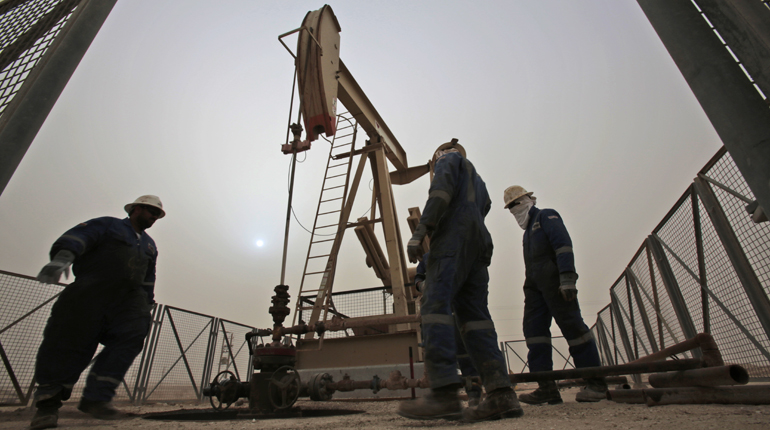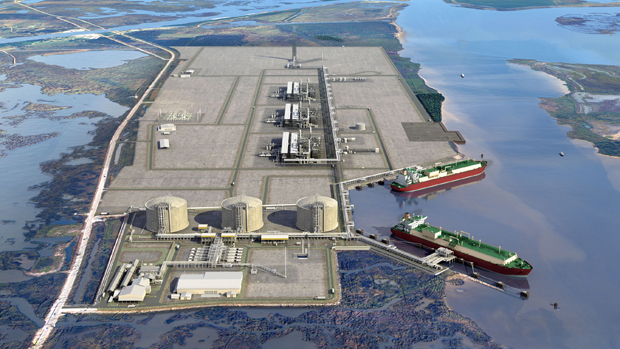 An oil pump in Bahrain. The country is looking to secure financing for an LNG terminal. (PA)
An oil pump in Bahrain. The country is looking to secure financing for an LNG terminal. (PA)
After a slow gestation, Bahrain’s entry to the LNG market is finally taking shape. Bahrain LNG approached banks in late July with the aim of securing $600-700 million in project finance debt.
Lender appetite could be high because the project is heavily backed with Asian export credit cover and is a vital part of Bahrain’s plan to meet demand from its gas-hungry local market.
However, it is less clear whether Bahrain LNG – the project consortium formed last year by Teekay LNG, Samsung C&T and Gulf Investment Corp. – will be able to realise the country’s longer-standing ambition to transform itself into a regional gas hub.
Domestic demand is looking robust. Energy-intensive companies such as Aluminium Bahrain (Alba) are planning capacity expansions and the kingdom’s electricity consumption is already getting close to matching its 4 GW of installed gas-fired generation capacity.
Bahrain’s domestic gas output is relatively small, at 15.3 billion cubic metres in 2015, one-third of which is used for power generation. Alba is planning a sixth potline at its plant as well as its own 1.35 GW power plant, which will require an additional 3.3 bcm/y when it is commissioned in 2019. That means Bahrain’s LNG terminal, which is due to come onstream by 2018, will have its work cut out – its initial capacity is only 4.1 bcm/y.
According to a senior Bahrain-based source, speaking on condition of anonymity, demand could still outstrip supply despite the influx of LNG. "Alba after its expansion will be using around one-third of Bahrain’s gas, and there is growing use of gas for injection into the Bahrain oil field," he pointed out.
The Bahrain LNG project, which will ultimately cost $900 million, will operate under a 20-year build-own-operate-transfer structure. The project is the first of its kind in the Gulf Cooperation Council region to be structured in this way The financial adviser is Société Générale.
Based at the Hidd industrial area, it will comprise an FSU, an offshore receiving jetty and breakwater, a regasification platform, subsea gas pipelines from the platform to shore, and an onshore facility.
The terminal is primarily intended to meet domestic gas demand. But despite plans to eventually double its capacity to 8.2 bcm/y, talk of Bahrain serving as an LNG hub – as mooted by Russian officials during a visit to Bahrain in early May – appears premature.
Hub ambitions
However, Gazprom appears convinced Bahrain will eventually become a hub. The company is working on creating an LNG distribution hub in the kingdom that would be able to import LNG from a variety of countries, with the potential to process several billion cubic metres per year. With Saudi Arabia publicly floating plans to import gas for the first time, Bahrain could be ideally positioned to service the region’s largest demand centre.
"In fact, in February of this year, Bahrain indicated to Russia that it would allow it to use the facility for re-exporting to other Gulf countries," said Justin Dargin, a Middle East energy specialist at Oxford University.
The foremost priority is securing enough domestic gas for the future. "At current rates of consumption, Bahrain only has enough domestically produced gas to last for roughly a decade," said Dargin. "Outside of a relatively small renewable energy programme, Bahrain almost completely relies upon gas for its power generation."
If the primary demand driver is domestic, the financiers considering participating in the LNG terminal financing package will need to be reassured that Bahrain can service its debt. Bahrain is not a net oil revenue generator and has experienced substantial political turbulence over the past five years.
The project costs are high for a country of Bahrain’s means but its sponsor, state-owned Nogaholding, had little trouble raising a $570 million Islamic loan earlier this year, part of which will also be used to fund construction of the LNG terminal.
"There is no reason why the [Bahrain LNG] lending package won’t get a strong reception from banks. Lenders will presumably want to look at projected demand for gas domestically and across the region, as well as the credit behind the capacity/hire payments and how strong the terminal and FSRU sponsor groups are," said Richard Nelson, a partner at law firm King & Spalding who specialises in LNG financing. "There’s also the question of how risks such as delayed delivery and start-up, vessel performance, [and] TUA/TCP termination will be addressed and allocated between NOGA and the other project stakeholders."
Poor planning and execution with much dithering and delay have been the downfall of many large energy schemes in Bahrain, which presents a risk for the LNG project.
But given that Bahrain LNG is a public-private partnership scheme, project sponsors will be focused strongly on its schedule. If there are delays, they will incur significant penalties. "Across the Gulf, delays are the norm not the exception with big projects of this kind," said the Bahrain source.
Meanwhile, the government has time to devise a viable strategy that could eventually see it transformed into a gas distribution hub for the region. But the message from Manama this summer is that it is firmly focused on getting the LNG terminal financed and built, leaving the blue-sky thinking for later.








Talk to us
Natural Gas Daily welcomes your comments. Email us at [email protected].